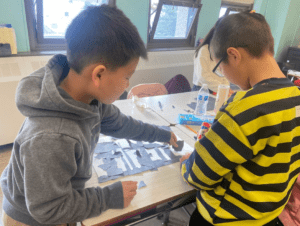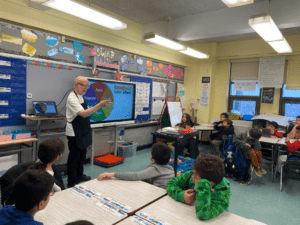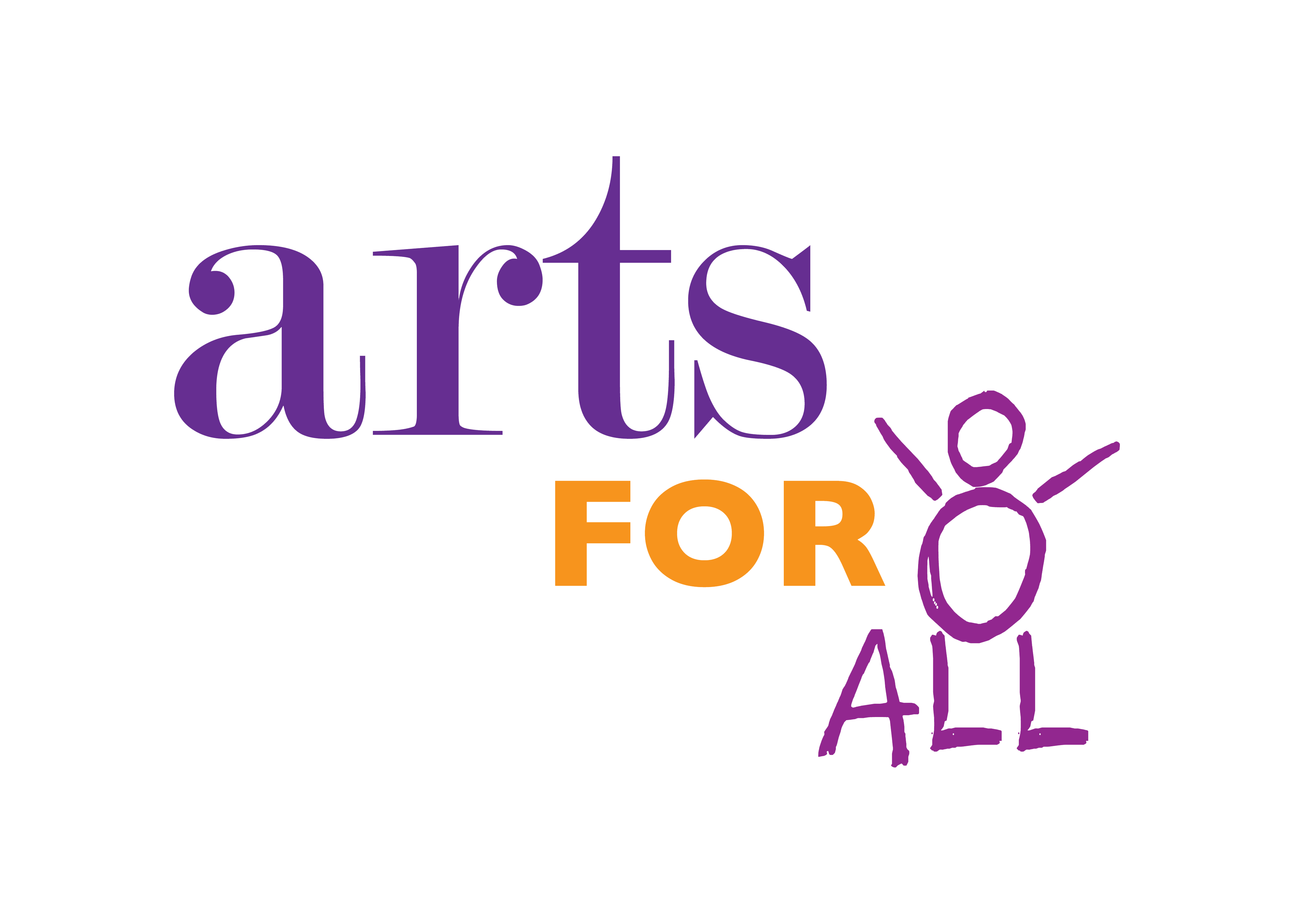Written by AFA Spring 2023 Intern Melody Fay Browning
January 27th, 2023

Photo By Melody Fay Browning
On Friday January 27th, I had the joy of spending a whole day with teaching artist Ron Chironna at PS 69 moving between six different third-grade classrooms with Ron’s artist residency. Ron began each class by doing a warmup where he talked about the importance of working with a team or a partner and asked the children to stand if they had ever worked with others on various things, such as doing homework, making artwork, watching movies or TV. The class then discussed the book “In Our Garden” that they had read prior to Ron’s visit, about a little girl who moves to a new city and builds a rooftop garden with the help of her new community. Ron then asked the children to partner up at their tables to collaborate on creating their own paper collage gardens. Ron and I passed out large pieces of white paper, sheets of black paper, and glue sticks. The children were tasked with tearing the black paper into shapes to make a silhouette garden and glue it to the white paper. It was so fun to see the children excitedly discuss with their partners what kind of garden they wanted to create. Many chose flowers, but others made fruits, vegetables, as well as various animals that inhabited their gardens. There was one little boy in the second class that was so excited and determined to make his garden perfect, and his teacher told us she had never seen him so focused or engrossed in a project. This really demonstrated the way art can speak to children and excite a part of them that they don’t normally get to experience. Ron then asked the children to share their gardens with each other and talk about what it was like working with a partner. Many shared that it was fun to work with someone else, and others said that it required compromise and creativity to combine both of their ideas to make something they were both happy with. It was so nice to see the way the children were able to collaborate with Ron’s guidance and create a piece of art that represented each pair’s ideas and creativity. I had so much fun talking to the children and watching them create. It was so heartwarming the way the children were so willing to share their creations with me, a new person in the room.
Teaching Artist Ron Chironna Interview:
Q: What factors do you think about when developing your lesson plans?
Ron: –amount of time available for the lesson.
–the actual physical space of the classroom, how crowded it might be, and how the desks, etc. are arranged.
–the age of the students and the appropriateness of the lessons and materials used.
–the physical, cognitive, and language abilities of the students and making sure that the lessons reach each student according to those abilities.
–the relevance of the lessons to their school lives, home lives, and background cultures.
–using examples of relevant art pieces that reflect some of the background cultures of the students and their families.
–teaching art methods that reflect those of practicing artists.
–whether or not the lesson should connect to school curricula.
–keeping the lessons flexible in order to be able to change things in mid-lesson, if necessary.
–keeping the lesson fun as well as educational.
Q: How do you navigate classrooms with children that are at different levels of learning and skill?
Ron: First of all, it’s important to have a planning meeting at which I can learn from the classroom teachers what those different levels may be for the individual students. It’s also vital that the teachers tell me how they compensate for the various levels of learning and skill. Much of what we do in the classroom is based on the experiences of the classroom teachers. Then it is up to me, with constant support from the classroom teachers, to be prepared to allow those students at higher levels to work more on their own after introducing the lesson and its activities and to be ready to use repetition of instructions, demonstrations, and appropriate visual, written, or oral displays to help the students at lower levels to be able to take part fully during the lesson. It’s also helpful to pair up students at different levels, so that they can help and inspire each other.
Q: What do you hope children in your classes take away from your lessons?
Ron: I want the students to see in art a real and exciting way to express themselves, especially for those who may have difficulties expressing themselves in other ways. I hope that they are able to learn and practice the art skills that we’re teaching for their own educational benefit and to add to the ways that they can have more fun. I want the students to learn about artists from all over the world and from different times, so that they can see how art has influenced all the cultures around the globe and how they’ve benefited society as a whole. While I don’t expect that many of them will become professional artists, I hope that the lessons will make art a part of their lives, whether art becomes a hobby or it activates their interest in going to museums, galleries, or even looking at art online. I also hope that the students realize that the processes we use in creating art can be used for other school subjects and in other parts of their lives. If art becomes ingrained, it will reflect in all avenues of their creativity.
February 17th, 2023

Photo By Melody Fay Browning
On Friday, February 17th I had the pleasure of joining teaching artist Ron Chironna for several classes at PS 69. Ron’s class was based around the idea of emotional acceptance, and Ron started each class by playing a quick game where he asked the children to stand if they experience a certain emotion when they do certain activities. Some of them were silly and some were accurate to emotions one might feel. For example, “Do you feel angry when you what your favorite TV show?’ or “Do you feel excited when you watch your favorite TV show?” Ron then discussed the book “Out of a Jar,” which is about a bunny who learns to accept his emotions rather than bottling them away. Next, Ron introduced the craft for the day, which was an abstract collage to represent a certain emotion. Ron explained the meaning of the word “abstract,” and then each table of children was given a certain color of paper and scissors to use for their collage which corresponded to one emotion. The children seemed to have a great time exploring what that emotion looked like to them when they tried to put it into a visual form. For example, several of the children assigned to red/angry ended up with collages that resembled flames of fire. To wrap up, Ron led the children in a reflection on the difference for them in creating last month’s collage vs this month’s and how the different techniques made it easier or more difficult and produced different results. It was great to see how excited the children were to create art and also how invested they were in the ideas behind their art.
